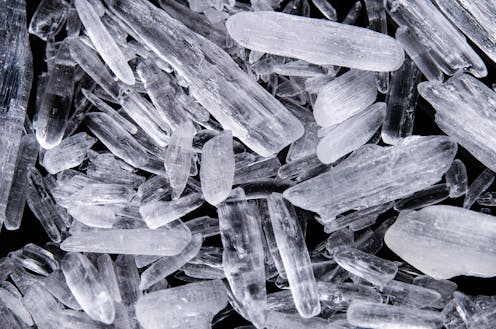Is meth use really going up? Let’s look at the evidence behind the latest scary headlines
- Written by Nicole Lee, Adjunct Professor at the National Drug Research Institute (Melbourne based), Curtin University

Widely reported data released from the National Wastewater Drug Monitoring Program this week appears to show the rising use of methamphetamine (also known as methylamphetamine). You may know it as speed (the powder form) or ice (the crystal form).
But this reporting appears to contradict data released in recent weeks from the National Drug Strategy Household Survey. This 2022-23 survey shows methamphetamine use is falling and is at its lowest in more than a decade.
So what’s going on? Is methamphetamine use rising or falling?
Read more: Meth use is declining in Australia – but the public still sees it as the most worrying drug
Looking at wastewater
The National Wastewater Drug Monitoring Program collects samples of wastewater from sewage treatment plants. University researchers then test samples for traces of different drugs.
The way the samples are analysed differentiates between drugs that have been consumed and drugs that have been disposed of before consumption. This means we know the drugs detected have actually been used and excreted via urine, not just thrown down the toilet.
Read more: Drugs in bugs: 69 pharmaceuticals found in invertebrates living in Melbourne's streams
But there are limitations
The report of the wastewater data mentions measuring “consumption”, “demand” and “harm” from drugs. But the wastewater program doesn’t measure these directly.
It only measures overall amount of a drug consumed in the community at a single point in time.
Wastewater data can’t tell us whether a small number of people have used a large amount of a drug or a large number of people each used a very small amount of a drug. It can only tell us the overall volume of a drug used.
Some of the sampling sites have been chosen specifically because the Australian Criminal Intelligence Commission, which runs the program, has an actual or potential concern that drug use is high in those areas. This kind of targeted sampling may overestimate how much of a drug has been used across Australia or at any given time point.
Read more: Weekly Dose: ice and speed, the drugs that kept soldiers awake and a president young
Surveys give us different answers
The National Drug Strategy Household Survey is a sample of, usually, around 20,000-25,000 households in Australia. It asks one person from each household aged 14 years and over about their use of a range of drugs in the past year and in their lifetime. Researchers refer to this as “self report”.
The survey asks about quantity, frequency and harms of drug use, and reports the data by a range of demographic measures such as age and gender. It also surveys the community’s attitudes to drugs. So the data is much more detailed than wastewater data.
Surveys have limitations too
The National Drug Strategy Household Survey relies on people being honest about their drug use.
People tend to forget or downplay their use, especially for illicit drugs, so the survey results likely underestimate use. But the underestimate is probably similar across years because the way the data is collected has remained very similar across time.
However, as the survey is anonymous and there are no consequences to disclosing this information (for example, no risk of being arrested for drug use) it’s probably reasonably accurate.
The survey is best for looking at trends over time.
Read more: Young people are drinking less in real life. But film and TV paints a different picture
So what can we make of this?
Over the years, there have been some ups and downs in methamphetamine volumes reported in the wastewater data. However, the average national volume (in kilos) of methamphetamine reported in the latest wastewater report is pretty close to the average for the past seven years.
The most recent report shows an increase in consumption per 1,000 population in regional areas, but a decrease in capital cities, representing an overall decrease. The total volume of methamphetamine used has increased, however. But as the population has also increased during that time, this complicates the picture.
Changes up and down in volume of drug used could also be seasonal or in response to short-term changes in availability. So it’s better to look at long-term changes over time together with other data.
The proportion of the population who report using methamphetamine in the National Drug Strategy Household Survey has fallen, continuing a long-term trend.
What’s the take-home message?
These two datasets measure different things at different time points using different methods.
The wastewater data found the average volume of methamphetamine had increased, but consumption per 1,000 population had decreased. This drop in consumption is in line with the survey, which found a drop in the percentage of people reporting methamphetamine use, the lowest in over a decade.
So is methamphetamine use in Australia rising or falling? Both sets of data actually suggest use is falling, even though you’d never know it from the recent headlines.
It’s a good demonstration of why we shouldn’t take data in isolation and why we need to consider a range of factors in interpreting data.
The last thing we want is sensationalised headlines, leading to the type of stigma that makes it harder for people who use drugs to ask for support.
If you are worried about your own or someone else’s drug use or just want further information you can call the free and confidential National Alcohol and Other Drug Hotline on 1800 250 015 or contact Counselling Online. Both services are available 24/7.
Authors: Nicole Lee, Adjunct Professor at the National Drug Research Institute (Melbourne based), Curtin University





